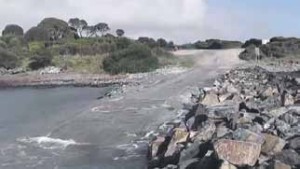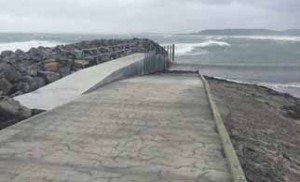 Presented from Issue 117, August 2015
Presented from Issue 117, August 2015
The editor Mike Stevens has asked me to write a short article about an underutilised fishery that we has recently become more accessible.
Opening out onto the waters of Bass Strait, the Weymouth area has long been acknowledged by those in the know (the locals) as one that produces quality recreational angling opportunities.
Up until recently and given the unpredictability of the predominate NW winds many avoided launching from here. The main obstacle was the substandard boat ramp and this troublesome facility often resulted in damage to expensive boats when launching or retrieving. Weymouth ramp upgrade
Thanks to a recent MAST upgrade the Trevor Street launching facilities are a huge improvement. Finished in early April 2015, these issues have to a large degree been addressed and this area now offers much safer accessibility for those who wish enjoy a day with family or mates.
That said, study the weather forecast before going anywhere, I own a 5.3 metre Quintex and as a rule of thumb if it’s over 10 knots I stay at home. My theory is there will be plenty of other days available to us down the track and with numerous inshore freshwater opportunities readily available should the urge to get out for a fish remain strong, what is the rush?
Also on safety, sometimes there is a quite strong tidal flow once you leave the Weymouth ramp that people in smaller craft or kayaks should be aware off.
What can I expect to catch?
Our main target is flathead, they are not as commonplace here compared with areas such as Great Oyster Bay and the fishing can be somewhat hit and miss, but the larger size more than makes up for the waiting time in-between bites.
Most common species caught are sandy and tiger flathead and size ranges around the 500mm mark are commonplace.
Other species regularly targeted are gummy shark and Salmon.
Unwelcome bycatch consists of small couta, wrasse, gurnard and wobbegong shark.
We are yet to pick up any calamari but are told they are quite prevalent here at the right time of year, with that in mind a squid jig hanging over the side is always worth a try.
 |
 |
| Before: A degraded, an often dangerous ramp |
After: Weymouth’s new Trevor Street ramp. This outstanding facility, improved by MAST with recreational funds is still weather and tide dependent, but launching and retrieving has been hugely improved |
Where to go?
In short, once you leave the ramp you are in Bass Strait, it’s not a stocked fish pond so it is unlikely any increase in recreational fishing pressure will have negative effect on one’s ability to catch a feed of fish.
Many say that you should head out to the 40 metre mark to gain success and I agree the flathead do seem a bit bigger overall out there,that said, the 20 metre mark seems to produce more bites and the fish size is still one of quality. The area around two kilometres off Stoney Head also produces bigger fish. Offshore, Ninth and Tenth islands can be accessed quite easily on a calm day.
Tenth Island holds a substantial seal colony and it is important to remember this was where a diver was taken by a Great White shark in years past, so please be careful. So there you are, as requested a very short overview of a local and readily accessed fishery for those in the north of this great state, I hope you give it a try and like us, find success.
Tips n tricks
As the depth of water you will be fishing is quite deep you may want to consider using a bigger reel. Something in the 6-8000 size is ideal as they have the power, but importantly they retrieve a lot of line per turn. After you wind five or six fish up from 40 metres of water you will understand what I mean. Your gear need not be expensive and a quick browse in any tackle shop will see you kitted out with a reel that will suit your needs. Match this up with a good boat rod and you’re ready to roll. Gear like this has neve been less expensive, nor the quality as good.
I prefer my reels spooled up with 80 pound braid, not because of the strength, but this heavier diameter tends to tangle less and you can feel every tap. I love the pink Sabiki rigs shown with a small amount of squid on the hook to add some flavour. These rigs are found in all quality tackle stores and are cheap at around five dollars each. As each rig has six hooks on it a good idea is to cut it in half and use three on each rod. Five hooks are the legal maximum anyway.
Sinker weight really depends on how fast the wind is blowing as you drift along. You must ensure your line is dragging across the bottom at all times. If your not in the ocean floor you won’t catch any flathead. Flathead are ambush predators and will strike aggressively at stirred up sand and colour as it goes past. Change your sinkers as needed to ensure you are on the bottom. Bites often come in the form of a constant light tapping on the line and you need to strike to hook them consistently.
If you miss them on the strike, immediately open your reel’s bail arm and feed the line back to the bottom. More often than not you feel the fish come back for another go.
Todd Lambert




